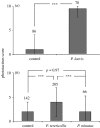Altered host behaviour and brain serotonergic activity caused by acanthocephalans: evidence for specificity
- PMID: 17015346
- PMCID: PMC1679890
- DOI: 10.1098/rspb.2006.3618
Altered host behaviour and brain serotonergic activity caused by acanthocephalans: evidence for specificity
Abstract
Manipulative parasites can alter the phenotype of intermediate hosts in various ways. However, it is unclear whether such changes are just by-products of infection or adaptive and enhance transmission to the final host. Here, we show that the alteration of serotonergic activity is functionally linked to the alteration of specific behaviour in the amphipod Gammarus pulex infected with acanthocephalan parasites. Pomphorhynchus laevis and, to a lesser extent, Pomphorhynchus tereticollis altered phototactism, but not geotactism, in G. pulex, whereas the reverse was true for Polymorphus minutus. Serotonin (5-hydroxytryptamine, 5-HT) injected to uninfected G. pulex mimicked the altered phototactism, but had no effect on geotactism. Photophilic G. pulex infected with P. laevis or P. tereticollis showed a 40% increase in brain 5-HT immunoreactivity compared to photophobic, uninfected individuals. In contrast, brain 5-HT immunoreactivity did not differ between P. minutus-infected and uninfected G. pulex. Finally, brain 5-HT immunoreactivity differed significantly among P. tereticollis-infected individuals in accordance with their degree of manipulation. Our results demonstrate that altered 5-HT activity is not the mere consequence of infection by acanthocephalans but is specifically linked to the disruption of host photophobic behaviour, whereas the alteration of other behaviours such as geotactism may rely on distinct physiological routes.
Figures





References
-
- Bakker T.C.M, Mazzi D, Zala S. Parasite-induced changes in behaviour and color make Gammarus pulex more prone to fish predation. Ecology. 1997;78:1098–1104. doi:10.2307/2265861 - DOI
-
- Bauchau A.G, Mengeot J.C. Sérotonine et glycémie chez les crustacés. Experientia. 1966;22:238–239. doi:10.1007/BF01900932 - DOI - PubMed
-
- Bauer A, Trouve S, Gre´goire A, Bollache L, Ce´zilly F. Differential influence of Pomphorhynchus laevis (Acanthocephala) on the behaviour of native and invader gammarid species. Int. J. Parasitol. 2000;30:1453–1457. doi:10.1016/S0020-7519(00)00138-7 - DOI - PubMed
-
- Bethel W.M, Holmes J.C. Correlation of development of altered evasive behavior in Gammarus lacustris (Amphipoda) harboring cystacanths of Polymorphus paradoxus (Acanthocephala) with the infectivity to the definitive host. J. Parasitol. 1974;60:272–274. - PubMed
-
- Budziakowski M.E, Mettrick D.F, Webb R.A. Aminergic neurons in the anterior nervous system of the rat acanthocephalan Moniliformis dubius. J. Neurobiol. 1983;14:313–325. doi:10.1002/neu.480140406 - DOI - PubMed
Publication types
MeSH terms
Substances
LinkOut - more resources
Full Text Sources

